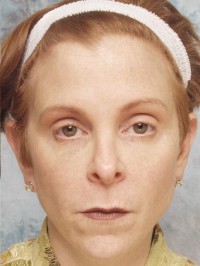Restylane for Dark Circles FAQ Beverly Hills
FREQUENTLY ASKED QUESTIONS ABOUT RESTYLANE TO TREAT DARK CIRCLES UNDER EYES
For your convenience, Dr. Steinsapir of LidLift has compiled a list of the most commonly asked questions about cosmetic Restylane to treat dark circles. If your question is not answered below, please do not hesitate to contact our private practice facility, located in Beverly Hills, California. We look forward to speaking with you, and are always available to answer any questions or concerns you may have.
How much Restylane® do I need under my eyes and how much will the service cost?
How much Restylane® you need very much depends on your facial anatomy and cosmetic goals. The key to a successful treatment is a personal assessment by Dr. Steinsapir. At the time of your visit, Dr. Steinsapir will conduct a thorough evaluation to determine the optimal volume to ensure full correction. Patients with average dark circles typically need about 1 ml of Restylane® under each eye; however, you may need more or less depending upon your unique facial structure. When financial considerations are an issue, Dr. Steinsapir will work with you to get the most from the treatment you are able to afford. After your initial assessment, Dr. Steinsapir will be able to give you a precise quote for your treatment.
Our office believes in providing a very high level of boutique care. All services are performed by Dr. Steinsapir, whose focus in on safely producing beautifully natural results with individualized treatment plans.
How come Dr. Steinsapir does not use permanent filler or fat to fill in dark under eye circles?
One of the most important things to understand about the under eye circle is how thin the eyelid skin is in this region. On the cheek, there is more flexibility in the choice of fillers because lumps and bumps can be concealed in the cheek fat. The delicate skin of the lower eyelid does not allow for any margin of error, which is why it is essential to work with a filler that can easily be adjusted after the treatment (if necessary). Permanent fillers ( i.e. Artefill® or silicone oil) and autologous fat transfers lack this flexibility, and surgery may be necessary if a lump is seen after the fat injection treatment. Even high-end fillers like Radiesse® and Sculptra® have been reported to produce visible irregularities at the surface of the skin, making them a less than ideal choice for under eye application.
What does Dr. Steinsapir think of Juvederm®? Why does he prefer Restylane®?
Dr. Steinsapir thinks that Juvederm®, which is also a sugar-based gel filler, is an excellent product. However, there are slight flow characteristics that differ between Juvederm® and Restylane®. Dr. Steinsapir finds that the relative “thickness” or viscosity of the Restylane® gel actually makes it easier to work with for the under eye area, in contrast to the smooth, thinner Juvederm® material. It is Dr. Steinsapir’s personal opinion that the higher viscosity of the Restylane® helps keep the material in place in the tissues of the lower eyelid/cheek interface. In fairness, both products seem to last about the same amount of time and can be adjusted at any time (if necessary) after they have been placed.
What does Dr. Steinsapir think of Restylane Lyft®?
Restylane Lyft® is distributed by Galderma, the same manufacturer as Restylane®. Restylane Lyft® is a comprised of a thicker material than Restylane® and seems to last a few months longer, often lasting well over a year, which is quite remarkable. Restylane Lyft® is fantastic for restoring depleted volume to the face, particularly to the cheeks, eyebrow, chin, and perioral area. Again, these areas have much more fat to work with than the lower eyelid dark circle. Dr. Steinsapir often utilizes Restylane Lyft® to add volume to the top of the cheek area as an effective way to complement the volumizing effects of Restylane® in the dark circle/lower eyelid hollow.
How long will my treatment last?
Restylane® appears to be quite long-lasting, with many patients reporting treatment benefits over a year. The exact time frame varies from patient to patient, and is dependent upon the rate at which each patient metabolizes the filler material. The key to long-term treatment success is ensuring substantial volume replacement with the initial treatment.
I had an under eye Restylane® treatment at a Medi-Spa a couple of years ago. I was really unhappy with that service and still have a visible bluish streak in my lower eyelid from the treatment. Is there anything that can be done about this?
This is a testament to how long Restylane® can last. Not all treatments are equal, and it is crucially important that your injections are administered by someone who really understands facial anatomy and how best to place the material. You may be surprised to learn that many Medi-Spas are actually illegal businesses. In California, the Medical Board requires that a doctor be on the premises and perform a good faith examination before a nurse can treat you. It is not sufficient to have a doctor serving in the capacity of “medical director” with no actual physical presence. It is best to be cautious and decline treatment if you have any concerns. The good news is that the bluish streak, which is a result of very superficial Restylane® administration, can easily be removed with a tiny nick in the skin or by injection with an enzyme (hyaluronidase) to break down the product.
How much downtime should I expect after my under eye Restylane® treatment?
Following under eye Restylane® treatment, there is around a 20% chance of bruising. The nature of the post-treatment bruising varies among patients—it may present as a little micro-bruise that will disappear in about 2-3 days, or as a more substantial, prominent bruise. The incidence of a black eye is only about 2%, and can take 2-3 weeks, possibly longer, to fully resolve. Aside from potential bruising, patients can also expect approximately 30-40 hours of mild swelling after treatment, which can easily be camouflaged with makeup.
What can I do to minimize the risk of bruising?
The risk of post-injection bruising can be mitigated by avoiding blood-thinning medications (i.e. Aspirin, ibuprofen, NSAIDS), and to refrain from consuming alcohol for 24 hours after treatment, as these substances tend to promote bruising. It may be surprising to learn that, although healthy under normal circumstances, red wine and most herbal supplements contain natural ingredients that can increase the risk of bruising, making it advisable to avoid these types of products for about 10 days prior to treatment. If you are not sure whether a product you use on a regular basis promotes bruising, please call the office and we can discuss this issue with you.
My doctor prescribed Coumadin® because I have a history of atrial fibrillation. Should I stop taking my Coumadin® before having under eye Restylane® treatment?
If you are taking an anti-coagulant medication prescribed by your doctor (i.e. Coumadin®, Plavix®, Xarelto, or even aspirin), do not stop taking your medications without consulting the doctor who prescribed them. If you are serious about seeking under eye Restylane® treatment, we advise scheduling a consultation with Dr. Steinsapir. He will assess your cosmetic goals and help balance them against your health issues. If he determines that you are a good candidate for treatment, it may be more reasonable to risk a bruise than to stop taking your anti-coagulant medications, which can be life threatening.


